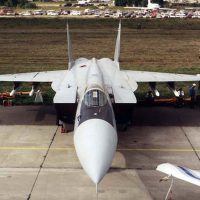Variants
- MiG-31 B
- MiG-31 BM
- MiG-31 BS
- MiG-31 E
- MiG-31 F
- MiG-31 M
Second production and service variant with improved Zaslon-A radar, ECM and EW equipment and with upgraded R-33S missiles. Replaced 01/01DZ in production in late 1990. Avionics upgrade includes A-723 long-range navigation system, compatible with Loran/Omega and Chaika ground stations.
Designation applied to proposed defence suppression variant based on MiG-31F. Demonstrator (14306 “58”), shown August 1998 with standard R-33S AAMs under fuselage, R-77, Kh-58 and Kh-31P underwing. Possible replacement for MiG-25BM in Russian Air Forces service. Designation now applied to single-role interceptor upgrade with K-37M and K-77M AAMs and new cockpit displays, to be applied to in-service MiG-31B. Two MiG-31BMs built by Sokol, but were inactive at MiG’s test airfield in late 2000, awaiting funding.
Designation applied to Type 01/01DZ when converted to MiG-31B standard.
Dedicated anti-satellite models (numbered 071 and 072) were produced and flight-tested in 1986, with ballast instead of radar in nose, a flat fuselage undersurface without recesses, large winglets above and below wingtips, and underwing Vympel ASAT missiles.
Export version of basic Type 01 Prototype (“903”) first noted 1997; simplified systems, no active jammer, downgraded IFF, radar and DASS. Offered to China, India and other countries.
Export version for Cannounced at Zhuhai Air Show 6 November 2000.
Projected multirole interceptor and fighter-bomber using a range of TV-, radar- and laser-guided ASMs. MiG-31F, FE and BM will all have improved air-to-air capability, with a radar upgrade based on technology developed for Zaslon-M of the MiG-31M. This will give a detection capability against ultra-high-speed targets (M6+), and much longer range, as well as better resolution and various new synthetic aperture and real-beam mapping modes for the variants’ new air-to-ground role. New versions will also have compatibility with advanced AAMs, including R-77 (AA-12 “Adder”) and long-range R-37. Revised cockpit layout includes new HUD, pilot’s tactical situation display – MFI-68 152 × 203 mm (6 × 8 in) colour LCD MFD – and three similar MFDs for the navigator. Some sources also suggest upgraded MiG-31s will incorporate structural modifications to increase service life.
Export version of MiG-31BM or MiG-31F. Alternative designation MiG-31MF.
Ejection seat testbed (Red “79”) used by LII.
Improved interceptor, under development since 1984; first prototype (‘051′) first flew 21 December 1985; first shown publicly February 1992; upgraded engines, with modified nozzles; one-piece rounded windscreen; small side windows only for rear cockpit (though dual controls are fitted); wider and deeper dorsal spine, containing 300 litres (79.3 US gallons; 66.0 Imp gallons) of additional fuel; more rounded wingtips, with flush dielectric areas at front and rear; taller fins with larger, curved root extensions; modified and extended wingroot leading-edge extensions; smaller wing upper-surface fences; all systems upgraded; digital flight controls; multifunction CRT cockpit displays; new multimode Phazotron Zaslon-M phased-array radar, with 1.40 m (55 in) diameter antenna, in 3º 30’ downward-inclined nose; detection range of 360 km (224 miles); retractable flight refuelling probe transferred to starboard side of nose; non-retractable pod with collimated IRST and laser ranger. No gun; number of fuselage weapon stations increased to six, by addition of two centreline stations with R-37 AAMs in addition to side-mounted R-37s or older R-33s; four new-type underwing pylons for R-77 (AA-12 “Adder”) active radar-guided AAMs. First prototype, produced by conversion of MiG-31B “503” lost on 9 August 1991; five or six more prototypes (051 to 057), at least one (057) with cylindrical wingtip ECM/ECCM jammer pods carrying upper and lower winglets. Maximum T-O weight 52,000 kg (114,640 lb), with increased-thrust D-30F6M engines to compensate. Internal fuel 16,350 kg (36,045 lb).
Commercial small satellite launch variant, with Fakel OKB Micron missile capable of delivering a 100 kg (220 lb) payload into a 200 km (124 mile) orbit or a 70 kg (154 lb) payload into a 500 km (311 mile) orbit. The type could also launch the Aerospace Rally System rocket-powered suborbital glider, for astronaut training upper atmosphere research or space tourism.






